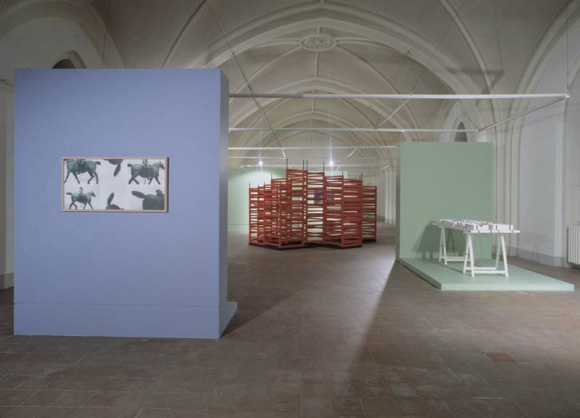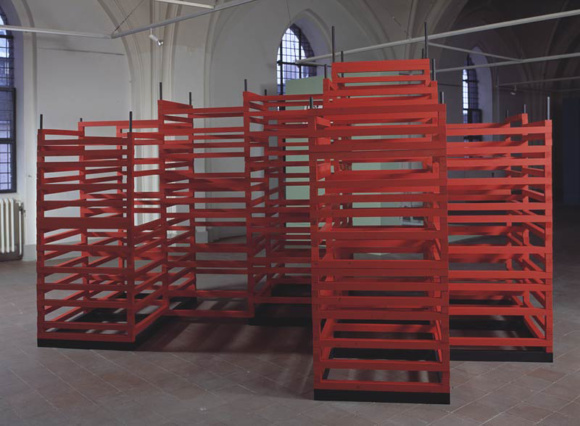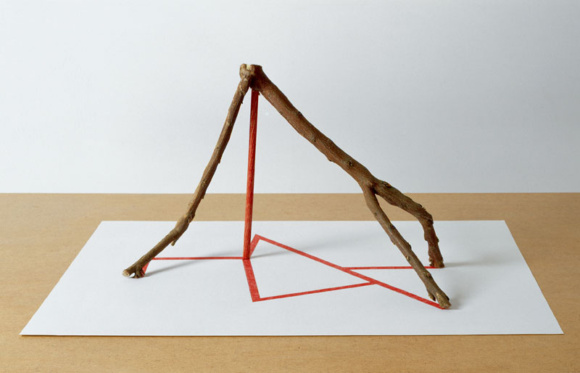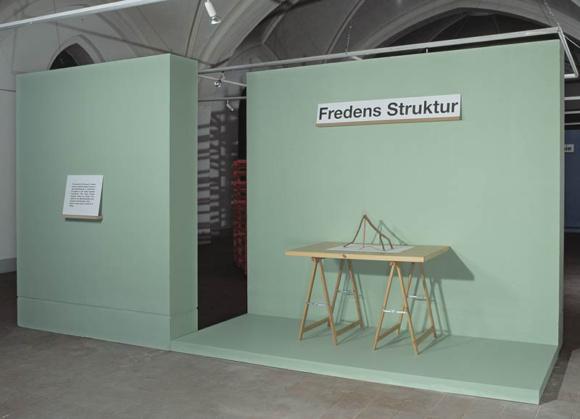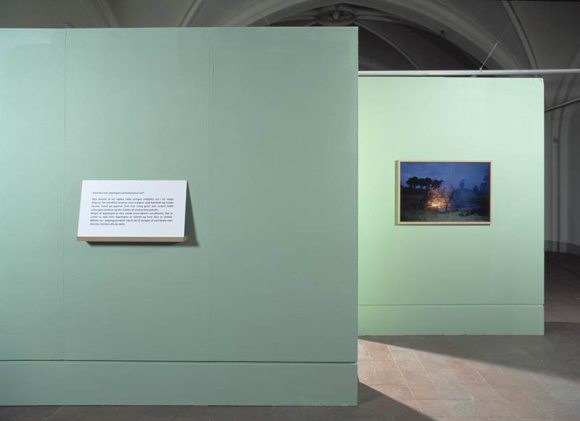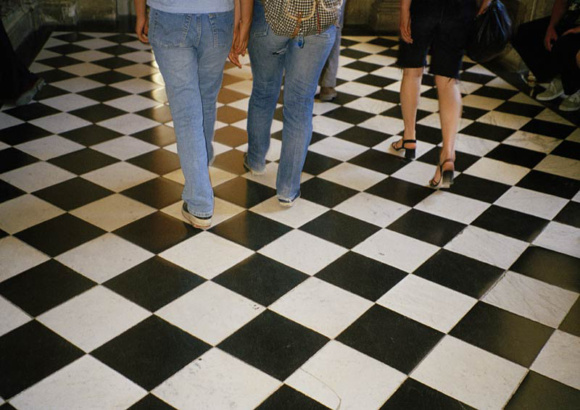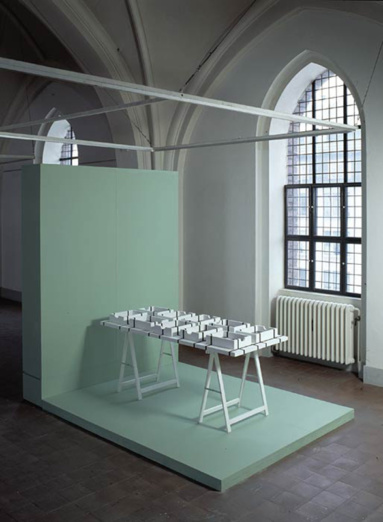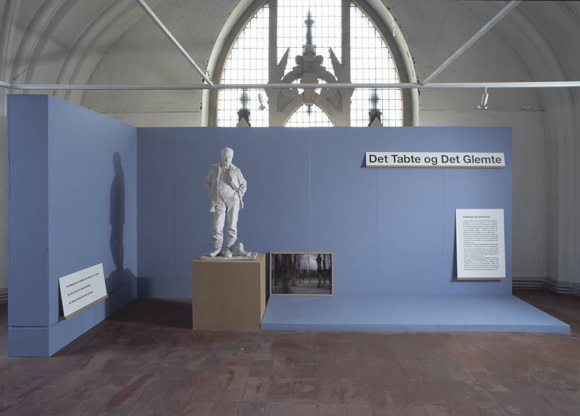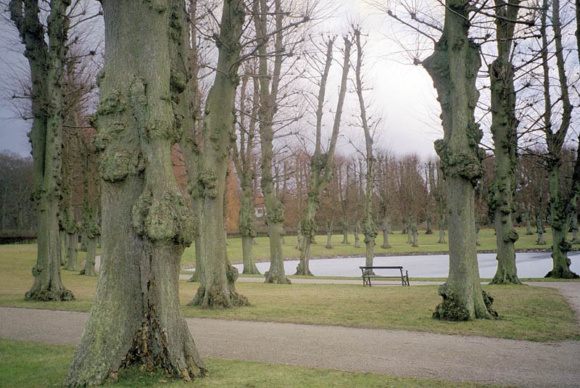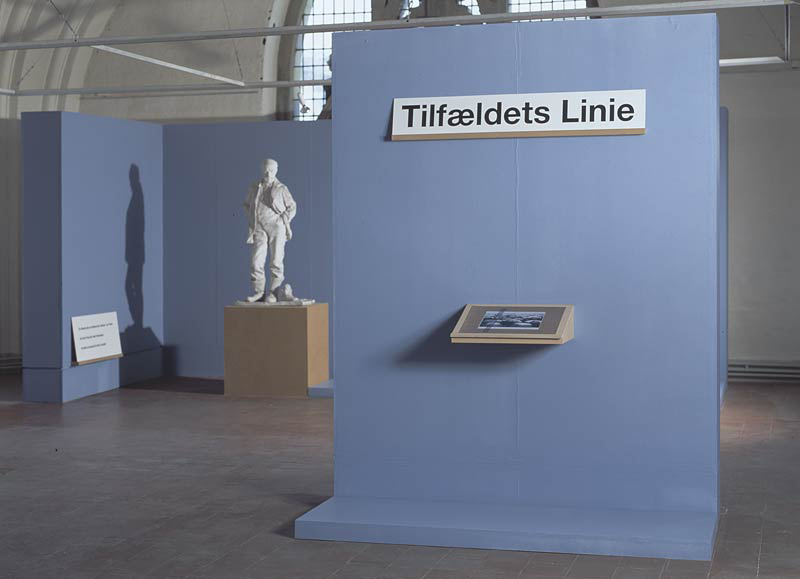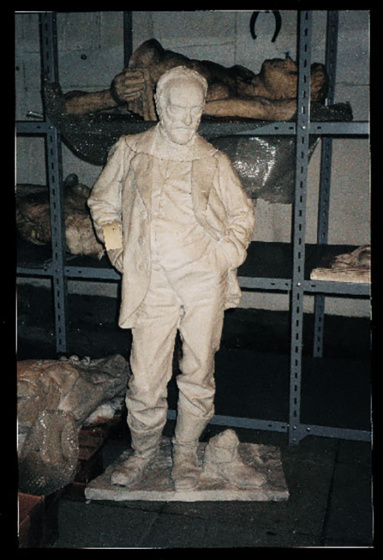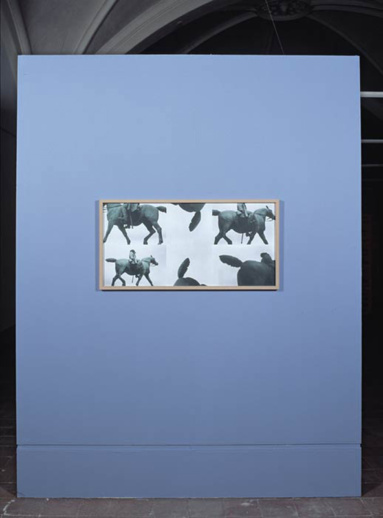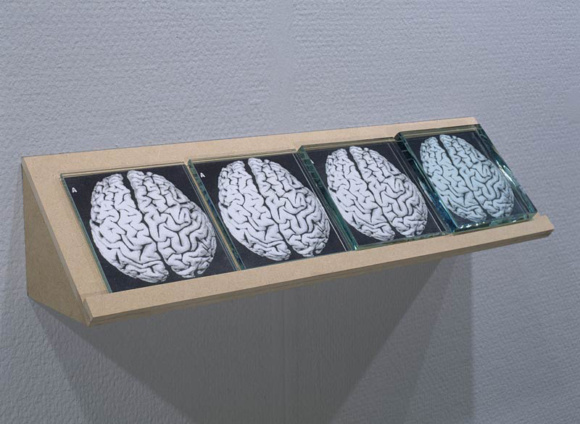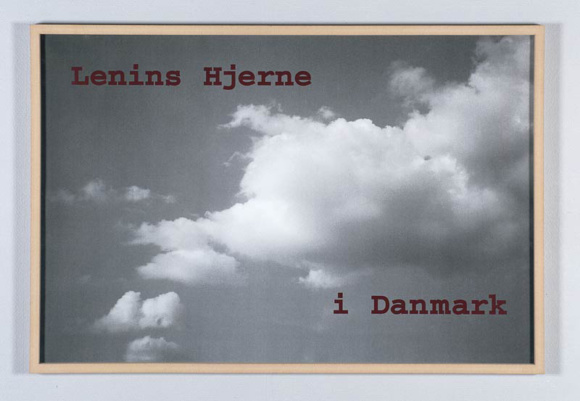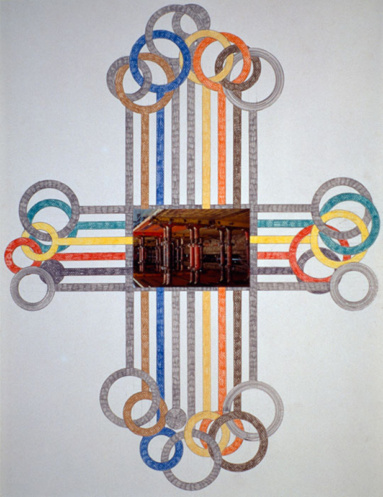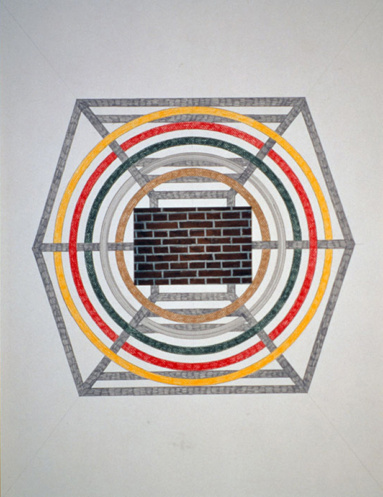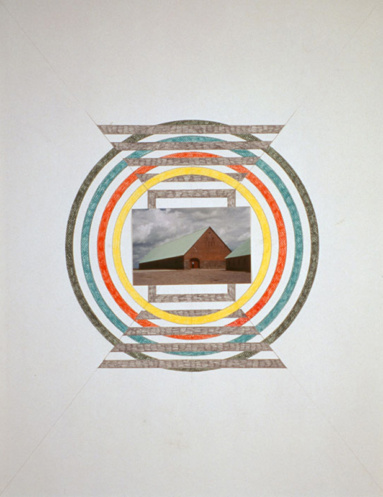THE MUSEUM OF_THOUGHT
ONE EXHIBITION; THREE SCENARIOS SHOWN AT NIKOLAJ COPENHAGEN CONTEMPORARY ART CENTER AND ESBJERG ART MUSEUM 2003
The exhibition unfolds as a journey through three scenarios, which all begins with a certain phenomenon: a blotting paper or a brain in a glass jar. The scenarios play on the ability of the human mind to form associations, make comparisons and connect various sensory perceptions. It also play on the sense of wonder. The exhibition is about placing oneself at the point where sense and nonsense meet.
Scenario 1
The Structure of Peace
At the Imperial War Museum in London there is a piece of blotting paper on which a drawing in red pencil has been dashed down. The paper bears the following inscription: ‘ Mr Lloyd George drew this during the meeting when the Terms of the Armistice were decided on. Versailles, Nov. 1918. Taken from his place by Herbert A Olivier.’
Questions: Why did Mr Lloyd George scribble on a blotting paper? Why did he use the colour red? Why did Herbert A Oliver keep the drawing? Is there a secret connection between the hand and the head that can be made visible? Can one see the peace negotiations in the drawing? Can one see the armistice? Can one see which year and where? Does any bagatelle at all become interesting just because it is part of an interesting context? Is it human nature to look for meaning no matter where? What motivated Herbert A Olivier? What does the drawing look like?
The drawing on the blotting paper consists of a series of red strokes that have been made to form a sort of filigree. A complex structure that traces its angular shapes around the paper. One stroke leads on to the next until the direction changes and ends with a flourish. Parts of the drawing are close, others loose in texture. It is difficult to say where the drawing started and where it finished. The point of departure may have been the few strokes of black ink one can just make out among all the red ones.
Scenario 2
The Lost and The Forgotten
In February 1948, the leader of the communists, Klement Gottwald, went out onto the balcony of one of Prague’s baroque palaces to speak to tens of thousands of citizens who had filled the square of the old part of the city. It was a historic moment in the history of Bohemia. A fateful moment of the kind that only occurs once or twice in the course of a thousand years. Gottwald was surrounded by his comrades, and right next to him stood Clementis. It was snowing slightly, it was cold – and Gottwald was bare-headed. The solicitous Clementis took off his fur hat and placed it on Gottwald’s head. The propaganda department made hundreds and thousands of copies of the photograph from the balcony, in which one saw Gottwald speaking to the masses with the sheepskin hat on his head and his comrades at his side. On this balcony, the history of communist Bohemia began. Every child is familiar with the photograph from poster, schoolbooks and museums. Four years later, Clementis was accused of treason and hanged. The propaganda department immediately erased him from history and naturally also excised him from all the photographs. Since then, Gottwald has stood alone on the balcony. Where Clementis once stood, there is only the bare wall of the palace. All that remains of him is the hat on Gottwald’s head.
Quotation: ‘The Book of Laughter and Forgetting’ by Milan Kundera
Questions: Was it a very special utterance from Gottwald’s mouth that caused Clementis to give him his hat? Did Clementis have a premonition concerning his coming fate which caused him intuitively to place the sheepskin hat on Gottwald’s head? Were there others on the balcony who might have been willing to lend Gottwald their hat? Can one see that the hat is not Gottwald’s? Did Gottwald keep the hat on after the speech on the balcony, or did Clementis get it back? Is a hat always the same hat, no matter who is wearing it? Can a hat remember? Do the bare walls of the palace point to something missing? Can a hat make up for Clementis’ missing presence? Will the hat try to find its original owner?
Scenario 3
Lenin’s Brain in Denmark
At the Institute of the Human Brain in Moscow, The brains of Lenin, Tchaikovsky and Gorky are kept preserved in glass jars.
Questions: Why are the brains of Lenin, Stalin, Tchaikovsky and Gorkij kept in glass jars at an institute? Is there a connection between the brain and genius which can be made visible? Can one see what a person has thought? Can one see what path thoughts have taken? Do the brains in glass jars tell us more about the brains that are alive than about the dead people who have supplied them? Does the brain of a politician look different from that of an artist? What would music composed by Lenin sound like? What would a political manifesto by Tchaikovsky look like? Can we be sure that genius only resides in the brain? Why is the whole person not in the glass jar?
Answers: Connecting human traits and skills with visible differences in brain structure is something that has fascinated scientists since the 1800´s, when Gall and Spurzheim proposed the theory of Phrenology. Even today, we scrutinize the brains of “geniuses” to determine whether there is some neural difference that can explain why their thinking seemed to be so out of the ordinary - so different from what we “average” people are capable of. It is an idea borne of the monist view that mind and brain are “one” and therefore, difference in “mind” must be the result, however subtle, of a difference in “brain”. - At any rate, there is no other organ in the body than the brain that plays a role when it comes to genius. - We are most grateful to you for asking these questions. - As soon as a person dies, considerable changes take place in the brain, which means that we are not in fact dealing with the same object at all as when the person was alive. - Right now, I believe that the brains in glass jars are in a sort of waiting position. - I am my brain. I am not my body. - Maybe it is more a coherence across many various areas of the brain that generates a thought than it is one neuron ‘speaking’ to another neuron. - I would like to correct myself. When I say the brain, I mean the brain and the nerve system. - It is an example of how much experimentation is taking place in science at present. - If Lenin had Tchaikovsky’s brain, he would write music like Tchaikovsky. But I would definitely prefer to live in a political system devised by Tchaikovsky than listen to music written by Lenin. - The brain has a modular structure. - These are very deep, philosophical questions. I have discussed them with my colleagues. I’m not sure we are able to answer them. - We are not at a point where we can trace a single thought as it moves around the brain. - I do not believe that the brain of a genius differs from yours and mine as regards electrical activity. The difference is rather that between a Peugeot 405 and a racing car. The Peugeot has a 1.8 litre engine, while the Formula 1 car, which can go quite a bit faster, only has a 1.6 litre one. But the Formula 1 car has a great deal of extra equipment which means, among other things, that the petrol is injected into the engine much faster and that the compression is much harder, so the rpm in the engine is much higher. Possibly, these are in principle the same processes that distinguish the brain of a genius from the average human brain. - We do not know anything about how small the differences in the brain actually have to be for a person to move from the ‘average’ to the ‘genius’ class. - In fact, a large part of the brain – is oriented not towards sense but towards ‘non-sense’, which it then struggles to make sense of. - Science is the greatest religion we have in society today.
